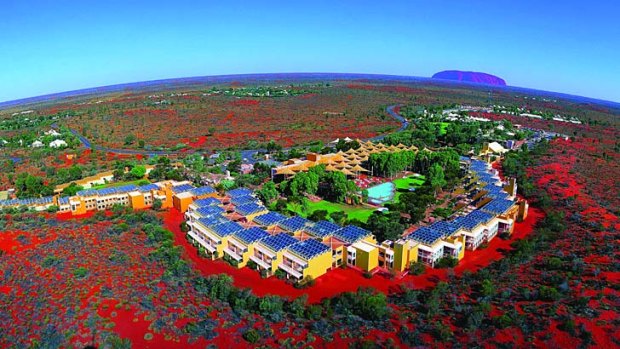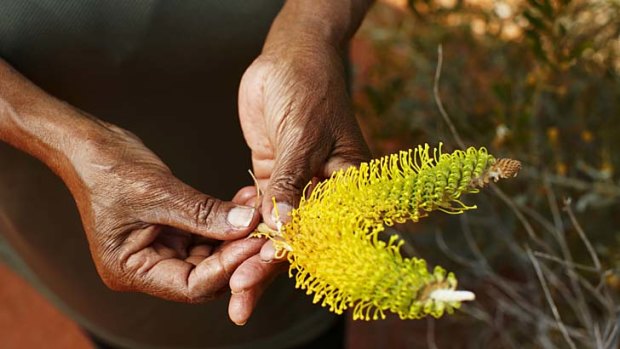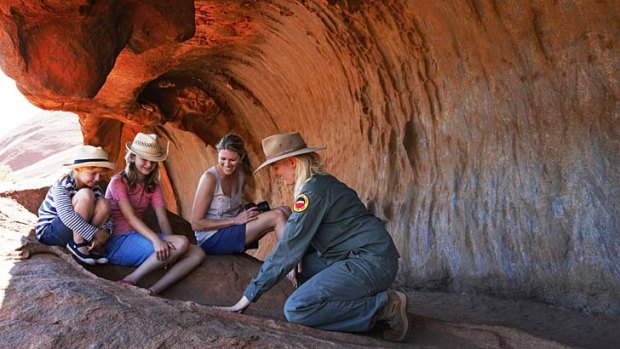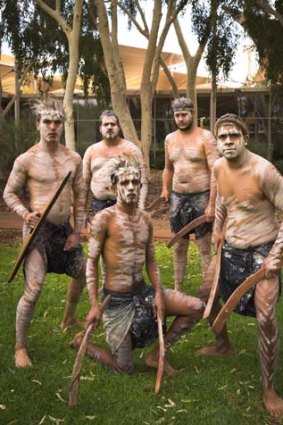
Red planet: Ayers Rock Resort.
There's no shortage of activities at our sacred monolith.
The dappled shade of a spreading eucalypt and a cool breeze dilute the bright outback sun at this early autumn hour. There are 10 of us, aged from eight to 80, enjoying the balmy morning, sitting in quiet contemplation under that big old gum tree. We're all trying our hand at dot painting, incorporating the symbols and language of the traditional art form we have newly learned.
It's a simple pleasure but the setting and authenticity - we are at Uluru and our teacher is a local indigenous artist of some note - make it special. It feels a real privilege to be spending a morning like this, and exhilarating too.

Bush tucker yarns at Circle of Sand.Credit: Anson Smart Photography
At the end of the session, we're so chuffed with what we've produced, we line up our paintings in the red dirt, take pictures and show them off on Instagram.
That's the clever thing about Ayers Rock Resort. As much as the rock and natural environment are the real stars of a visit to Uluru-Kata Tjuta National Park, some visitors, especially families with young ones to entertain, want to do more than just gaze at its ever-changing colours, as remarkable as they are. And of course, seeing Uluru is a thrill for any Australian child lucky enough to go. But recognising short attention spans and family holiday value expectations, Ayers Rock Resort offers a range of experiences to engage visitors of all ages with the landscape, people and history of the area.
We take advantage of the free stuff: the dance demonstrations, spear throwing and boomerang wrangling. It all could err on the cheesy side. It doesn't, by virtue of the fact these activities are run by indigenous staff who are empowered to bring their personality into their event. And by the incredible location, of course. Where better for all that, really. Even for ardent non-participators, it's hard to not join in. Additionally, they're daily, most no longer than a half hour or so, and scheduled around each other. Combined with the bigger commitment and bigger ticket items such as tours and dinner experiences, and a bit of time by the pool, they flesh out a perfect winter break at the rock.

Fun for the kids.
One of our options of the bigger ticket kind, is a walk into Walpa Gorge at Kata-Tjuta, the formidable range of soaring sedimentary domes also known as the Olgas. It's a powerful, awe-inspiring, up-close experience of the scale and spirit of the centre. Another choice is Desert Awakenings. While pre-dawn the masses line up at the free public viewing sites for sunrise over Uluru, we bundle into a mini-bus that takes our small group to an exclusive site atop a dune within clear range of the rock. It's not our lucky day - dark cloud shrouds the landscape.
But being outside with a view of Uluru at dawn, enjoying coffee, damper and egg and bacon rolls, we find to be special, despite the lack of spectacular colour we know others have enjoyed in finer weather. Then we travel in our bus to the foot of the rock for a walk and we find colour abounding. Uluru has a slick copper sheen and the spinifex at its base glows daffodil yellow in vivid response to the gently persistent autumn rain. We feel privileged to see it in this glorious state.
Alex, our guide is oblivious to the wet as he imparts stories of battles between the Kuniya and Liru, mighty, mystical pythons. "There are no happy endings here," Alex says as his boots splash through ochre puddles along the path to Mututjulu waterhole, which lies in the voluptuous folds of the rock's south-east face. "These stories are warnings about the consequences of bad behaviour for the young who come here to be initiated. They're violent and bloody."

The Wakagetti Cultural Dancers.Credit: Adam Bruzzone
Kuniya and Liru are central to Tjukurpa, the code of beliefs and morality of the Anangu, the people indigenous to this vast, flat, desert region. We've all heard these stories, or bits of them, before, most likely. And perhaps we were a little interested. Or perhaps, they were assigned to a back-of-mind, amorphous awareness of Australia's indigenous roots. But standing at the apex of Tjukurpa, we're as oblivious to the wet as is Alex. The features of the rock that he points out to be the visual representations of Tjukurpa are amazingly unambiguous. We can clearly see the snakes in the rock, the shape of a man's head, the cracks in a skull, the sliced-off nose Alex speaks of, among other figures of his narrative. Suddenly, the stories, heard in classrooms or on documentaries are dramatically alive. They hold us mesmerised. Alex notices this and smiles. "Imagine the young blokes coming here for initiation. They hear all these stories, then they see this and, wow, it's real. They must have been terrified - awestruck."
Standing at the base of this 600-million-year-old, 348-metre-high monolith, it's hard to disagree.
Though the initiation Alex speaks of is a highly sacred and secretive business of young male Aborigines, there's a magic about coming to Uluru that doesn't differentiate. Young, old, male, female, indigenous or not, all who come here are touched in one way or another.
And particularly for Australian kids, it can be a rite of passage that garners a greater understanding of their place on their continent and in the world.
TRIP NOTES
GETTING THERE
Both Jetstar and Virgin Australia fly to Ayers Rock Airport, which just a short drive or transfer to the main resort at Yulara. See jetstar.com; virgin.com.
STAYING THERE
Voyages Indigenous Tourism Australia has a two-night package running that includes two nights' accommodation at Ayers Rock Resort, Ayers Rock Airport transfers. From $272 a person twin share (with the kids free). For three nights, the price is from $357 a person twin share. Phone 1300 134 044; see voyages.com.au.
SEE + DO
The Dot Painting Workshop costs $195 for a family of two adults, two children. SEIT Kata Tjuta Tour: $119 an adult, $96 each child under 15. Desert Awakenings: $168 a person, $130 a child under 15. The Red Ochre Spa at Sails in the Desert has massage and beauty therapies. See ayersrockresort.com.au/red-ochre-spa.
DINING THERE
Tali Wiru ($325 a person) is a four-course dinner with wine served in an exclusive spot. See ayersrockresort. com.au/tali-wiru.
MORE INFORMATION
Sign up for the Traveller Deals newsletter
Get exclusive travel deals delivered straight to your inbox. Sign up now.